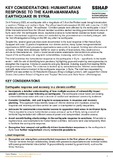Key Considerations: Humanitarian Response to the Kahramanmaraş Earthquake in Syria
اعتبارات أساسية: الاستجابة الإنسانية لزلزال كهرمان مرعش في سوريا
| dc.contributor.author | Ekzayez, Abdulkarim | |
| dc.date.accessioned | 2023-06-26T13:06:33Z | |
| dc.date.available | 2023-06-26T13:06:33Z | |
| dc.date.issued | 2023-06-26 | |
| dc.identifier.citation | Ekzayez, A. (2023) Key Considerations: Humanitarian Response to the Kahramanmaraş Earthquake in Syria. Social Science in Humanitarian Action Platform (SSHAP) http://www.doi.org/10.19088/SSHAP.2023.018 | en |
| dc.identifier.citation | ||
| dc.identifier.citation | اقتباس مقترح: إكزايز، أ. (2023). اعتبارات أساسية: الاستجابة الإنسانية لزلزال كهرمان مرعش في سوريا. منصة العلوم الاجتماعية في العمل الإنساني http://www.doi.org/10.19088/SSHAP.2023.021 | ar |
| dc.identifier.uri | https://opendocs.ids.ac.uk/opendocs/handle/20.500.12413/18027 | |
| dc.description.abstract | On 6 February 2023, an earthquake with a magnitude of 7.8 on the Richter scale brought destruction to southern Türkiye and northern Syria. The official death toll exceeded 50,000, with more than 7,000 fatalities occurring in Syria.1 An estimated 12 million people were affected by the earthquake in total.2 While international aid from the UN and member countries started reaching government-held areas in Syria soon after the earthquake struck, equitable access to humanitarian assistance faced multiple barriers. International support to areas not controlled by the government was markedly delayed, with the first UN delegation arriving on the fifth day after the earthquake. Despite this, several good practices were documented in the local response in Northwest Syria. Equipped with over 12 years of experience in a chronic conflict, many Syrian non-governmental organisations (NGO) and grassroots organisations were quick to respond, forming new alliances and consortia. If these were developed further to cover a variety of local actors, they could act as a vehicle for international aid. Such a model would enable sustainable interventions to address the impact of the earthquake and long-term vulnerabilities, increasing community resilience. This brief examines the humanitarian response to the earthquake in Syria – specifically in the health sector – with the aim of identifying best practices, highlighting gaps and exploring new approaches to strengthen the response. It draws on academic and grey literature, including reports from leading NGOs and government agencies. The evidence is backed up by consultations and informal conversations held with stakeholders involved in the earthquake response in Syria. The brief was requested by SSHAP and was written by Dr Abdulkarim Ekzayez (King’s College London), with support from Diane Duclos (the London School of Hygiene and Tropical Medicine) and Soha Karam (Anthrologica). | en |
| dc.description.abstract | في السادس من فبراير 2023، ضرب زلزال بقوة 7.8 على مقياس ريختر كلاً من جنوب تركيا وشمال سوريا، وأحدث دمارًا كبيرًا، حيث بلغت الحصيلة الرسمية للقتلى ما يزيد عن 50000 قتيل من ضمنهم 7000 في سوريا1. وقد تأثر بهذا الزلزال ما يقارب 12 مليون نسمة في المجموع2. وبينما بدأت المساعدات الإنسانية بالوصول إلى المناطق التي تسيطر عليها الحكومة، وذلك من جهة الأمم المتحدة والدول الأعضاء، في وقت مبكر بعد حدوث الزلزال، فإن الوصول العادل للمساعدات الإنسانية واجه عوائق عديدة. كما أن الدعم الدولي الذي لا تسيطر عليه الحكومة تأخر بشكل ملحوظ، حيث وصل أول وفد للأمم المتحدة في اليوم الخامس بعد الزلزال. وبالرغم من ذلك، فقد تم توثيق عدد من الممارسات الجيدة في الاستجابة المحلية في شمال غرب سوريا. فكونها مجهزة بأكثر من 12 عاماً من الخبرة في صراع مزمن، فإن العديد من المنظمات السورية غير الحكومية والمنظمات الشعبية كانت سريعة في الاستجابة، وذلك من خلال تشكيل تحالفات واتحادات جديدة. وإذا تم تطويرها بشكل أفضل لتغطي عدد أوسع من الجهات الفاعلة المحلية، فيمكن لهذه المنظمات العمل كوسيلة للمساعدات الدولية. وقد يسمح مثل هذا النموذج القيام بتدخلات مستدامة للتعامل مع آثار الزلزال ونقاط الضعف طويلة المدى، وبالتالي زيادة قدرة المجتمع على الصمود. يقوم هذا الموجز بدراسة الاستجابة الإنسانية للزلزال في سوريا، وفي القطاع الصحي على وجه الخصوص، وذلك بهدف تحديد أفضل الممارسات، وتسليط الضوء على الفجوات، واستكشاف المناهج الجديدة لتعزيز الاستجابة. وتعتمد الدراسة على الأدبيات الأكاديمية والرمادية، بما يشمل تقارير صادرة عن منظمات غير حكومية رائدة وهيئات حكومية. كما أن الأدلة مدعومة باستشارات ونقاشات غير رسمية تم اجراؤها مع أصحاب المصلحة المعنيين بالاستجابة للزلزال في سوريا. وتم طلب هذا الموجز من قبل منصة العلوم الاجتماعية في العمل الإنساني، وقام بكتابته د. عبد الكريم إكزايز (كلية كينجز لندن) وبمساعدة من ديان دوكلوس (مدرسة لندن لحفظ الصحة وطب المناطق الحارة)، بالإضافة إلى سهى كرم (أنثرولوجيكا). | ar |
| dc.language.iso | en | en |
| dc.publisher | Institute of Development Studies | en |
| dc.rights.uri | http://creativecommons.org/licenses/by/4.0/ | en |
| dc.title | Key Considerations: Humanitarian Response to the Kahramanmaraş Earthquake in Syria | en |
| dc.title | اعتبارات أساسية: الاستجابة الإنسانية لزلزال كهرمان مرعش في سوريا | ar |
| dc.rights.holder | Institute of Development Studies | en |
| dc.identifier.doi | http://www.doi.org/10.19088/SSHAP.2023.018 | |
| dc.identifier.doi | http://www.doi.org/10.19088/SSHAP.2023.021 | |
| rioxxterms.funder | Default funder | en |
| rioxxterms.identifier.project | SSHAP | en |
| rioxxterms.version | VoR | en |
| rioxxterms.versionofrecord | http://www.doi.org/10.19088/SSHAP.2023.018 | en |
| rioxxterms.funder.project | 499a73d7-4329-4db9-b540-459876887aa3 | en |



